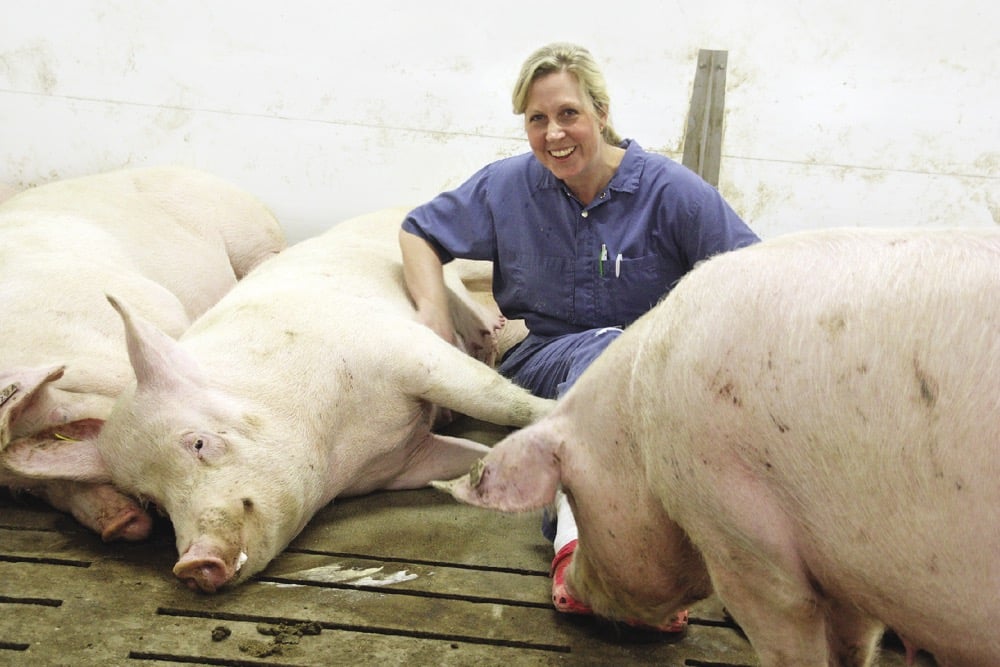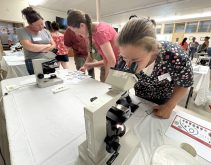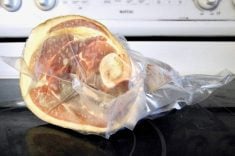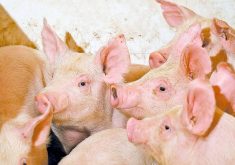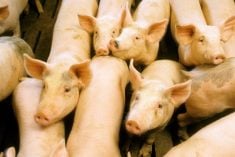Livestock farmers across Canada are bracing for extra costs as Health Canada moves to further lock down their access to antimicrobials, but Huron Country hog farmers Tara and Dennis Terpstra anticipate an easy transition.
When their business arrangement changed in 2015, the Terpstras seized the opportunity to re-evaluate their herd management. The result was a significant change in how they treat sick pigs. They medicate them individually and only when all other options have been tried.
Why it matters: Farmers will retain full access to antimicrobials for treatment, but some farmers, like Tara Terpstra are part of production systems that aim for pigs that have never seen antimicrobials.
Read Also

BinSentry sensors reduce feed-bin outages
BinSentry sensors mean fewer feed bin outages and more efficient deliver for feed mills.
When they were caring for 1,000 sows farrow-to-finish on three sites, “I always felt there was low immunity in the sow barn and with no control over the management of the sow barn,” said Tara, who talked about her experience at the London Swine Conference.
They were always reactive to health problems, resulting in the use of blanket antibiotics. It didn’t make a lot of sense to her. If one of her family members is sick, they don’t give everyone antibiotics.
For the first 15 years after she and Dennis married, she helped manage the books, but not the barns.
That all changed in 2015 when they scaled back to a 350 sow, farrow-to-finish operation, in a new barn built for loose sow housing and which meant Tara began her career directly managing sows in the barn.
A self-proclaimed “city girl” who grew up in Cambridge with no farming experience, she says she brings her consumer eyes to the operation. The new barn has a lot of windows, compared to the usually windowless modern hog barn.
“If I have to work in there, I wanted lots of windows,” she said.
She has a more holistic approach to managing sows, with the aim of preventing illness, managing sows individually and limiting use of antibiotics in a Raised Without Antibiotics (RWA) program.

They can still use antimicrobials, but those treated pigs then end up in a regular pork marketing stream versus the premium RWA program.
Stacey Ash, communications manager at Ontario Pork says they don’t know exactly how many pigs are produced in RWA programs, but it’s estimated at about 10 per cent.
Terpstra had several tips for farmers looking to manage pig production without antibiotics. They include:
Keep the bugs out. That’s a challenge for them on the border of Huron and Perth counties, one of the most intensive hog production areas in the country. There are eight hog farms within a kilometre of the farm. They limit deliveries and will often time purchases so that there can be one delivery in a month. Good entry protocols, and rodent and fly control can also help limit entry of disease. Even so, they had a Porcine Respiratory and Reproductive Sydrome (PRRS) outbreak last year.
Keep things dry. The housing environment is important, and is highly influenced by effective ventilation.
Manage nutrition. This can include deciding which 100 acres of corn looks the cleanest and carries the lowest level of mycotoxins and making sure that’s the corn that’s fed to the sows. Corn carrying a high mycotoxin load can result in reproduction problems for sows. The Terpstras target feeding strategies that increase immunity. They use various nutraceuticals, including putting oregano oil through the water to help reduce bacteria loads.
Monitor sow behaviour and diagnose problems quicker. Walk pens daily to look for injuries, ripped dewclaws, blood and manure. They turn to anti-inflammatories first to help a sow feel better.
Do your research and get training. The Terpstras were able to access funding for training from a Growing Forward 2 program. They also use some homeopathic products such as eucalyptus and did their research to support that use. They will treat piglets carefully at processing for tail docking and castration, to avoid infections that need to be treated with antibiotics. This includes treating scraped cheeks with zinc oxide on the wound, and scraped knuckles with hoof fit gel high in copper and zinc. They are also bandaged for three days.
Don’t be afraid to change. Data management became integral as they moved to individual sow care. Terpstra has also added other items to her management toolbox, including feeding potato starch to piglets in the farrowing crate. She gives a metre-long piece of burlap to sows two days before farrowing for them to use for nesting and then she finds piglets will curl up with that piece of burlap because it smells like their mother. She finds using the burlap helps limit the amount of sedative (Stresnil) that needs to be given to the sows. She has also added toys for the pigs in the nursery.
Do your own on-farm trials. In trying to limit antibiotic use they have tried leaving animals without treatment. They’ve found pigs will often get better without an antibiotic. Find the points at which a decision to use an antibiotic is made. They’ll look at the whole pig, checking feed consumption, temperature, colour of coat, body language such as a curved back, her stools and any vulva discharge. They will start with a drench of essential oils three to four times per day along with banamine for pain before moving to antibiotics.
“Antibiotics are great. I want them in my toolbox, but they also kill good bugs too. I want to find a balance,” said Terpstra.




